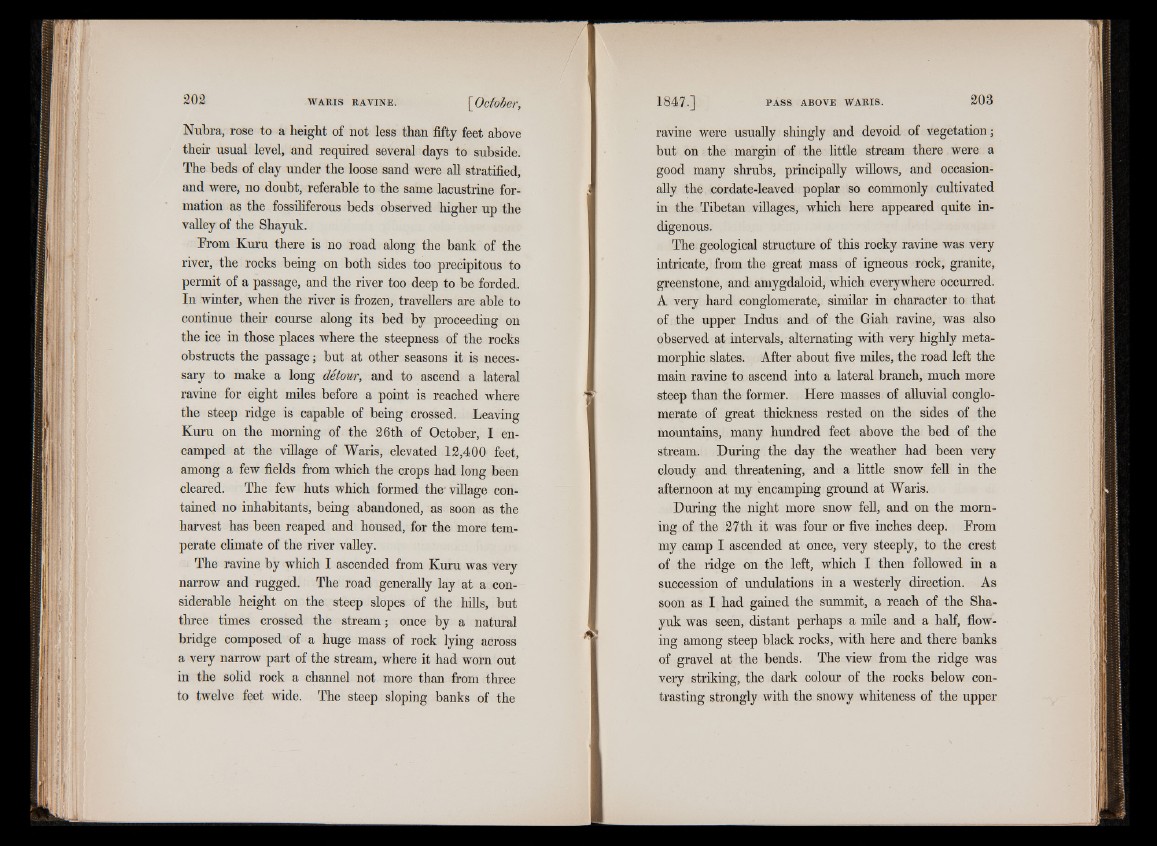
Nubra, rose to a height of not less than fifty feet above
their usual level, and required several days to subside.
The beds of clay under the loose sand were all stratified,
and were, no doubt, referable to the same lacustrine formation
as the fossiliferous beds observed higher up the
valley of the Shayuk.
From Kuru there is no road along the bank of the
river, the rocks being on both sides too precipitous to
permit of a passage, and the river too deep to be forded.
In winter, when the river is frozen, travellers are able to
continue their course along its bed by proceeding on
the ice in those places where the steepness of the rocks
obstructs the passage; but at other seasons it is necessary
to make a long detour, and to ascend a lateral
ravine for eight miles before a point is reached where
the steep ridge is capable of being crossed. Leaving
Kuru on the morning of the 26th of October, I encamped
at the village of Waris, elevated 12,400 feet,
among a few fields from which the crops had long been
cleared. The few huts which formed the* village contained
no inhabitants, being abandoned, as soon as the
harvest has been reaped and housed, for the more temperate
climate of the river valley.
The ravine by which I ascended from Kuru was very
narrow and rugged. The road generally lay at a considerable
height on the steep slopes of the hills, but
three times crossed the stream; once by a natural
bridge composed of a huge mass of rock lying across
a very narrow part of the stream, where it had worn out
in the solid rock a channel not more than from three
to twelve feet wide. The steep sloping banks of the
ravine were usually shingly and devoid of vegetation;
but on the margin of the little stream there were a
good many shrubs, principally willows, and occasionally
the cordate-leaved poplar so commonly cultivated
in the Tibetan villages, which here appeared quite indigenous.
The geological structure of this rocky ravine was very
intricate, from the great mass of igneous rock, granite,
greenstone, and amygdaloid, which everywhere occurred.
A very hard conglomerate, similar in character to that
of the upper Indus and of the Giah ravine, was also
observed at intervals, alternating with very highly meta-
morphic slates. After about five miles, the road left the
main ravine to ascend into a lateral branch, much more
steep than the former. Here masses of alluvial conglomerate
of great thickness rested on the sides of the
mountains, many hundred feet above the bed of the
stream. During the day the weather had been very
cloudy and threatening, and a little snow fell in the
afternoon at my encamping ground at Waris.
During the night more snow fell, and on the morning
of the 27th it was four or five inches deep. From
my camp I ascended at once, very steeply, to the crest
of the ridge on the left, which I then followed in a
succession of undulations in a westerly direction. As
soon as I had gained the summit, a reach of the Shayuk
was seen, distant perhaps a mile and a half, flowing
among steep black rocks, with here and there banks
of gravel at the bends. The view from the ridge was
very striking, the dark colour of the rocks below contrasting
strongly with the snowy whiteness of the upper